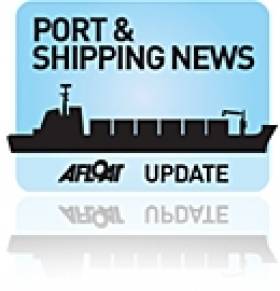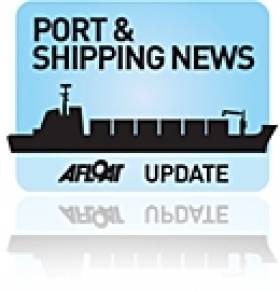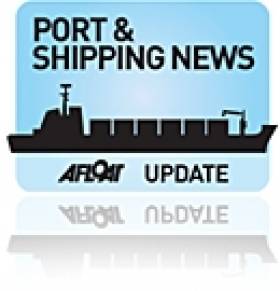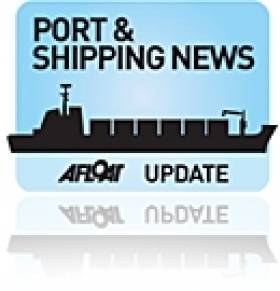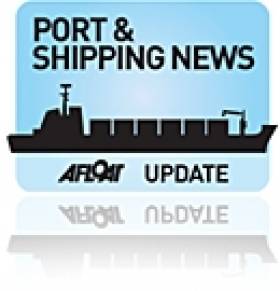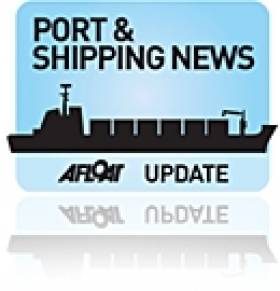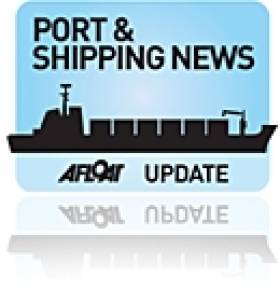Displaying items by tag: IMDO Shipping Review
IMDO Shipping Review: 24,000TEU On the Horizon, US Approve Oil Exports, Irish Motor Sales Drive Growth and much more
#Ports&Shipping –The latest IMDO Weekly Shipping Market Review includes the following stories as detailed below.
Container Market: 24,000 TEU containership on the horizon - Work on building a 24,000 TEU containership–5,000 TEU bigger than the current largest vessel–is set to begin in just two years time, according to a leading maritime consultant. Seatrade Global reported that technical feasibility studies have been concluded and show that at-sea costs for a 24,000 TEU vessel would be 23.1% lower versus a 12,500 TEU vessel and 17.4% lower versus a 16,000 TEU vessel.
Tanker Market: US approves limited unrefined oil exports - The administration of US President Barack Obama has approved the limited export of ultra-light crude oil (or oil condensates) for the first time in over forty years, TradeWinds reported. Two firms–Pioneer Natural Resources and Enterprise Product Partners– were given permission by the Department of Commerce to export minimally processed ultra-light crude, known as condensates, from shale oil deposits in Texas.
Irish Economy: Motor sales drive May retail growth - The volume of retail sales rose 0.9% month-on-month in May, while increasing 6.2% compared with May 2013 according to the latest figures from the Central Statistics Office (CSO). Motor sales proved the main factor in this expansion, rising 4.6% compared with April. Excluding motor sales, month-on-month volumes would have contracted 0.5% and on an annual basis, would only have risen 3.2%.
For more on each of the above and other stories click the PDF downloadable IMDO Weekly Markets Review (Week 26). In addition to coverage on Afloat.ie's dedicated Ports & Shipping News section.
IMDO Shipping Review: 40ft Cubes to Dominate, Call for Fair Sulphur Enforcement, Irish Growth Broader-Based and much more
#Ports&Shipping –The latest IMDO Weekly Shipping Market Review includes the following stories as detailed below.
Container Market: 40ft high cubes to dominate market - High cube 40ft containers are soon expected to overtake conventional 40ft boxes as the main transport equipment in the maritime container fleet, according to Drewry Maritime Research's latest 'Container Census Report'. Figures show high cube boxes represented almost 50% of all containers in use at the close of 2013, growing 7% in the year–outpacing overall container fleet growth of 4.3%.
Regulation: Shipowners call for fair sulphur directive enforcement - Shipowner organisations have called on regulators to implement the upcoming European Sulphur Directive in a "harmonised and realistic" manner. The Directive–set to come into force on January 1st 2015 and which will require all ships in the Sulphur Emission Control Areas (SECAs) to reduce the sulphur content of their bunker fuel to a maximum 0.1%.
Irish Economy: Growth revival more broad-based - The Irish economy is expected to rebound strongly in 2014, with GDP growth of 2%, following a contraction of 0.3% in 2013. The latest EY Economic Eye report, produce by Ernst & Young, highlighted the emerging signs of recovery in domestic demand as one of the key positive trends. Domestic demand is expected to contribute positively to GDP growth this year for the first time since the onset of the financial crisis, with consumer sentiment, property prices and mortgage arrears already beginning to show signs of a stabilisation in the domestic economy.
For more on each of the above and other stories click the PDF downloadable IMDO Weekly Markets Review (Week 25). In addition to coverage on Afloat.ie's dedicated Ports & Shipping News section.
IMDO Shipping Review: Asia-Europe Growth Continues, Dry-Bulk Market Struggles, Obama Signs Port Infrastructure Bill and much more
#Ports&Shipping –The latest IMDO Weekly Shipping Market Review includes the following stories as detailed below.
Container Market: Asia-Europe volumes continue strongly -Container volumes from Asia to Europe continued their strong growth in April, with the sub-routes to the Western Mediterranean and North Africa showing the largest volume increases of 6%. The latest Container Trade Statistics figures as reported by Lloyds List show that overall Asia-Europe volumes increased in April 5.2% year-on-year to 1.2m teu, meaning that for the first four months of the year, volumes have increase 5.8% year-on-year to reach 4.7m teu.
Dry Bulk Market: Across the board declines -The dry bulk market continues to struggle with its overall lacklustre performance. The Baltic Dry Index (BDI) remained hovering below the 1,000 point mark last week, as the index declined 96 points across the week to finish at 906. All sub-segments saw declines,with the Capesize market losing part of the momentum it had developed over the previous week.
US Ports: New infrastructure and dredging bill signed -The Barack Obama signed into law last week the US Water Resources Reform and Development Act of 2014, a $12.3bn water-projects plan to invest in infrastructure and deepening of US ports to allow for larger ships and reduce costs for exporters. The plan is the first water infrastructure bill since 2007 and authorises 34 projects including dredging, flood control, hurricane recovery and environmental restoration. A key driver it to provide funding for dredging of US ports to allow them to accommodate the larger ships that will soon be traversing the newly-expanded Panama Canal.
For more on each of the above and other stories click the PDF downloadable IMDO Weekly Markets Review (Week 24). In addition to coverage on Afloat.ie's dedicated Ports & Shipping News section.
#Ports&Shipping –The latest IMDO Weekly Shipping Market Review includes the following stories as detailed below.
Container Market: Further rate volatility predicted - Container shipping rates have been forecast to remain volatile for the coming months as carriers on Asia-Europe trades benefit from superior capacity management than on Transpacific and intra-Asia lanes, which continue to suffer from vessel cascading. The Shanghai Containerised Freight Index (SCFI) has continued to decline on Asia-Europe trades of late, however HSBC's latest Transport Indicator forecasts Asia-Europe freight rates will remain relatively high while Trans-pacific spot rates will struggle despite attempts from Transpacific Stabilization Agreement (TSA) lines to enforce General Rate Increases (GRI).
Product Market: Dramatic changes to Atlantic sector - Last year the transatlantic product tanker market saw positivity and strong earnings between $15,000-$20,000 a day, spurring a surge of new orders as optimism grew according to Clarksons Research Ltd. However at the moment MR product tanker earnings are between $4,000-$8,000 with year-to-date earnings averaging $8,0000-$14,000 a day. The market sea-change is attributed to the near-demise of Europe's refining industry, once the dominant region in the product sector, coupled with the resurgence of US refining due to their domestic shale boom.
Short Sea Market: Weekly update -The European Short Sea Bulk market experienced flat to soft activity last week according to H.C. Shipping & Chartering's latest report, in a replica vein to the recent period of sluggishness. Activity was said to be patchy with the current supply/demand imbalance becoming increasingly acute with an abundance spot tonnage and owners keen for whatever cargoes they can cover.
For more on each of the above and other stories click the PDF downloadable IMDO Weekly Markets Review (Week 23). In addition to coverage on Afloat.ie's dedicated Ports & Shipping News section.
IMDO Shipping Review: Africa Upsizes, Misplaced Optimism Overcapacity, New Marine Wood Fuel and Much More
#Ports&Shipping –The latest IMDO Weekly Shipping Market Review includes the following stories as detailed below.
Container Market: African upsizing -The upsizing of vessels on African trades continues strongly accordingly to Clarksons Research Limited supported by robust growth in trade volumes and despite a variety of infrastructure challenges. A number of services to West Africa have been reorganised and now Panamaxes and 4,500 TEU 'Wafmaxes' (the largest geared containerships in world) are regularly being deployed instead of 2-3,000 TEU geared vessels.
World Fleet: Misplaced optimism regarding overcapacity -The growing optimism regarding the perceived improvement of the supply-demand balance is overplayed according to a report by Danish Ship Finance (DSF). DSF contend that whilst several major shipping segments, particularly the crude and dry-bulk sectors, have benefitted from an improved supply-demand balance, overcapacity remains a systemic issue not merely, "temporary spikes, driven by regional imbalances and inventory changes". Seaborne trade volumes increased 2.8% in 2013, against world fleet growth of 3.7%, resulting in fleet utilisation of just 83% according to DSF.
Marine Fuels: New fuel development from wood residues - Researchers at Britain's Aston University claim to be developing a marine fuel using waste from the Norwegian forestry industry, with the potential for the large-scale production of a "completely sustainable" biofuel by 2020. The ReShip Project aims to process low-quality wood waste and chips into crude pyrolysis oil, by heating the material without exposing it to oxygen.
For more on each of the above and other stories click the PDF downloadable IMDO Weekly Markets Review (Week 22). In addition to coverage on Afloat.ie's dedicated Ports & Shipping News section.
IMDO Shipping Review: Container Market Idle, Rotterdam Europe’s Top Tonnage Port, Short Sea Sector Soft Activity and more
#Ports&Shipping –The latest IMDO Weekly Shipping Market Review includes the following stories as detailed below.
Container Market: Idle box - fleet falls but overcapacity prevalent - The idle containership fleet has edged below 2% of the overall fleet for the first time since last September. Figures from Lloyd's List Intelligence show that total capacity of inactive vessels fell to 335,640 TEU last week, standing lower than for the corresponding week over the last two years, when 2.6% of the fleet was idle.
Rotterdam Port: Volume increases maintain Europe's top spot- The Port of Rotterdam maintained its position as Europe's largest tonnage port in 2013, with throughput totalling some 440.5m tonnes. Rotterdam experienced a slight increase in overall throughput as dry bulk volumes rose amid declining liquid cargoes. Dry bulk volumes increased strongly, rising 12.8% from 2012 to 89.2m tonnes, with particularly noticeable growth of around 20% in coal throughput to 30.7m tonnes.
Short Sea Market: Weekly update - The European Short Sea Bulk market saw flat to softer activity last week according to H.C. Shipping & Chartering's latest report. The market remained on its same trajectory, experiencing the continued downward trend that started developing in early April which has since become prevalent. The supply/demand balance is reportedly skewed with large volumes of spot tonnage available but struggling to find cargoes.
For more on each of the above and other stories click the PDF downloadable IMDO Weekly Markets Review (Week 21). In addition to coverage on Afloat.ie's dedicated Ports & Shipping News section.
IMDO Shipping Review: ‘Box’ Ship Demolitions Up, Private Funding Could Upset Recovery, Solution to Satellite Blackout and more
#Ports&Shipping –The latest IMDO Weekly Shipping Market Review includes the following stories as detailed below.
Container Market: Demolitions to hit new record in 2014 - A record number of container ships are set to be scrapped this year, as reported demolitions in the first four months of the year reached 212,000 twenty equivalent units (TEU), up 27% year-on-year.
Shipping Industry: Private equity funding could threaten recovery - The rise of private equity funding in the shipping industry, which has seen billions of dollars invested in new vessel orders, threatens to cut short the sectors emergence from its worst downturn since the 1980's, Reuters have reported.
Technology: Radio navigation solution to satellite blackouts -Europe has yet to come to terms with the danger that satellite blackouts and signal jamming present for the maritime industry, Reuters reported last week.
Presently, the industry relies on satellite-based GPS and GLONASS (Global Navigation Satellite System) for time and positioning. However, the General Lighthouse Authorities of the UK and Ireland (GLA) have pioneered a radio-based back-up system, called eLoran, which would continue to provide users with the correct time and vessel position in the event of a loss of satellite signal due to solar weather effects, interference or even intentional jamming of satellites.
Irish Economy: Trade surplus at six-year low - March's preliminary figures from the CSO indicate the trade surplus fell by €732m to €2.4bn, the lowest seasonally adjusted surplus since July 2008. Seasonally adjusted exports fell 4% (€256m) to €6.9bn from February while seasonally adjusted imports rose 12% (€437m) to €4.5bn in what analysts described as disappointing data.
Comparing March year-on-year, the value of exports decreased by €524million (-6%) to €7.56bn with the main drivers being organic chemicals decreasing 16% and medical and pharmaceutical products falling 10%.
For more on each of the above and other stories click the PDF downloadable IMDO Weekly Markets Review (Week 20). In addition to coverage on Afloat.ie's dedicated Ports & Shipping News section.
#Ports&Shipping –The latest IMDO Weekly Shipping Market Review includes the following stories as detailed below.
Container Market: Reliability improves for first time this year - The reliability of container carrier lines improved for the first time this year in March, according to the latest Global Schedule Reliability report from SeaIntel Maritime Analysis. The report found that 72.3% of vessels arrived on time, up from February's 68.4%. Whilst March saw improvements, reliability is still considerably lower than last year's level of 82.8% for March.
Tanker Market: LNG fleet surpasses 400 mark - The Liquid Natural Gas (LNG) carrier fleet surpassed the 400 vessel mark for the first time mid-April. The global LNG carrier fleet has experienced a remarkable growth path since the first commercial cargo of LNG was delivered from Algeria to the UK almost 50 years ago, in October 1964.
Freight Modes: Air freight loses out to sea transportation - Sea transportation has been annually taking 100,000 TEU away from air freight for the last 10 years, according to a report published by transportation consultancy Seabury. The study found that 5.4m tonnes of cargo had shifted from air to sea transportation since 2000, with much of the shift attributable to the increasing standards of refrigeration technology aboard ships.
Regulation: IMO closes in on mandatory container weighting – The International Maritime Organisation (IMO) are said to be very close to amending the SOLAS convention to make it a mandatory requirement to verify the gross weight of containers before loading aboard a ship. The mis-declaration of container weights has been a concern to the maritime industry for some years, potentially contributing to a number of incidents.
For more on each of the above and other stories click the PDF downloadable of the IMDO Weekly Markets Review (Week 19).
In addition to coverage on Afloat.ie's dedicated Ports & Shipping News section.
#Ports&Shipping –The latest IMDO Weekly Shipping Market Review includes the following stories as detailed below.
Container Market: Surplus to remain as slow steaming is here to stay - Overcapacity in the container market is expected to persist until 2017 at the earliest, according to research by Braemer Seascope, who further estimate an additional 12 Asia-Europe strings could be established during this period based on expected deliveries of ultra-large containerships, Lloyd's List reported. Currently, overcapacity in the market stands at 30%, without accounting for the effects of slow steaming and vessel lay-ups.
Regulation: A French proposal to force foreign trucks onto its motorways and off of the corresponding A-roads has been widely criticised by the EU. Lloyd's Loading List reported that the proposal came as an alternative to the country's HGV tax scheme which was postponed in autumn last year owing to significant opposition.
Innovation: First maritime carbon credit scheme - In an industry first, a carbon credit scheme has been established by International Paint (IP) and The Gold Standard Foundation to reward shipowners who invest in environmentally friendly technology.
Seatrade Global reported that under the scheme, owners who upgrade from biocide-based antifouling to International's Intersleek hull coating will qualify for receiving a quantity of carbon credits from the Gold Standard Foundation proportional to the bunker savings achieved by using the Intersleek coating.
For more on each of the above and other stories click the downloadable PDF IMDO Weekly Markets Review (Week 18). In addition to coverage on Afloat.ie's dedicated Ports & Shipping News section.
IMDO Shipping Review: G6 Plan 'Mega-Box' Ships, Dry Bulk Newbuilds up 72%, Panama Canal Strike Action Again and more
#Ports&Shipping –The latest IMDO Weekly Shipping Market Review includes the following stories as detailed below.
Container Market: G6 proposes mega-boxship orders -The G6 liner alliance is planning to outdo P3, its main rival, by ordering even larger container ships than Maersk's Triple-E which can carry 18,000 (TEU) twenty equivalent foot-long units.
According to TradeWinds, G6 are considering up to 20 vessels over 19,000 TEU as analysts profess cost efficiencies, based on larger cargo volumes per ship, and economies of scale are crucial for G6 to successfully compete on the Asia-Europe trade routes with P3.
Alphaliner data shows that currently the average size of P3 ships is around 10,300 TEU in comparison 8,200 TEU for G6. The deal is expected to continue to fuel market overcapacity, with analysts believing that 21,000 TEU can be the absolute maximum size given yard and port constraints; however plans for 23,000 TEU ships have been drawn up.
Dry Bulk Newbuilds: Newbuild orders up 72% in March -Dry bulk newbuild market investment soared 72% year-on-year in March as some 140 vessels were ordered, up from 81 bulkers last year.
Statistics shows that 113 of the vessels are to be built in China with the most popular builds being Ultramaxes and Kamsarmaxes with 47 and 36 orders respectively.
Asian owners account for over half of March's orders following growing optimism from the large improvement in freight rates towards the end of 2013.
Infrastructure: Panama Canal hit by further strike action -The Panama Canal expansion works have once again been stopped, according to SeaTrade Global.
An indefinite nationwide strike has been called by the main construction union in the country, the Construction Workers National Union, who are demanding higher wages for their members. The canal expansion works are already 14 months behind schedule due to previous difficulties and Grupo Unidos por el Canal (GUPC), the European consortium building the third set of new locks, said in a statement that "construction workers, union members are heeding the call to strike.
For more on each of the above and other stories click the downloadable PDF IMDO Weekly Markets Review (Week 17). In addition to coverage on Afloat.ie's dedicated Ports & Shipping News section.


























